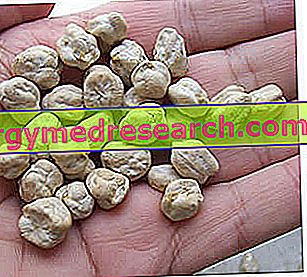Introduction
Chickpeas are the seeds of Cicer arietinum, a herbaceous plant belonging to the fabaceae or leguminosae family. It is therefore a matter of legumes, whose food use is only possible after drying.
The chickpea plants are particularly cultivated in Umbria, Lazio, Tuscany and especially in Liguria (remember the typical local specialty based on chickpea flour: farinata); however, all chickpea plants are grown in most Mediterranean regions.
Botanical analysis

After soy and bean, chickpea is the third leguminous plant for global production: in Italy, however, it is not much cultivated, mainly due to poorly adapted soil, low yield and, above all, low market demand.
Nutritional analysis
Dried chickpeas are very caloric legumes: in fact they provide about 316 Kcal per 100g: so much so that, once cooked, they contain over 6% fat, compared to 2% of beans. However, chickpeas are much more balanced in terms of macronutrient distribution, as well as being very energetic. Some authors venture to attribute therapeutic properties to chickpeas: in fact, these legumes are rich in saponins, very useful for decreasing the levels of cholesterol and triglycerides in the blood.
In addition, chickpeas are a source of vegetable proteins, fiber, B vitamins (B1, B2, B3, B5, B6), vitamin C and E. In chickpeas there are also some minerals (such as magnesium and phosphorus ). Furthermore, these precious legumes, unfortunately little consumed in our country, contain a fair amount of polyunsaturated fatty acids (especially linoleic acid).
Chickpeas also seem to boast mild antacid properties (useful, therefore, in conditions of stomach acid); the consumption of chickpeas can also be a possible aid against gastroduodenal ulcers (properties not fully demonstrated).
Chickpea uses
After drying, the chickpeas must be placed in cold water for about 12 hours before being cooked. Afterwards, the chickpeas can be boiled and subsequently crushed, therefore consumed as a puree.
In the East, the crushed chickpeas are mixed with sesame seeds, lemon and oil, to prepare the humus . Particular is the consumption of natural chickpeas, after having naturally macerated, dried on ash and toasted.
Dried chickpeas are used mainly for the preparation of flour.
chickpea flour
Excellent alternative to wheat flour, chickpea flour is obtained by grinding dried chickpea seeds; it is a food rich in minerals, such as calcium, phosphorus, iron, and vegetable protein.
The dried chickpeas are milled to cylinders or stone (of superior quality). The chickpea grinding process involves refining, since the separation of the bran is essential.
Chickpea flour is widely used in Liguria, where farinata is considered a typical local specialty. Farinata is a very low chickpea cake, kneaded only with chickpea flour, water, salt and olive oil; the farinata is usually cooked in a wood oven, but sometimes cooked in a pan.
Chickpea flour is also used for the production of panissa, another Ligurian culinary specialty: this chickpea cake is covered with onions.
Chickpea flour can also be used mixed with durum wheat flour and eggs to prepare fresh pasta; still, it can be used as a base element for the batter (for vegetables) and to prepare gnocchi.
Chickpea flour in history
The earliest archaeological evidence of the cultivation of Cicer arietinum derives from Iraq and dates back to the ancient Bronze Age (3, 500-1, 200 BC). Afterwards, the cultivation of chickpea spread in Egypt and the Roman Empire. Currently, the chickpeas and flour obtained are consumed mainly in India and Pakistan.
Chickpea soup
The Personal Cooker Alice explains in detail how to enhance chickpeas in the kitchen, with a rich and tasty chickpea soup, with celery, bacon and carrots.
Chickpea soup
X Problems with video playback? Reload from YouTube Go to Video Page Go to Video Recipes Section Watch the video on youtubeSummary
Chickpeas: in short
| Chickpeas | Seeds of Cicer arietinum, herbaceous plant belonging to the Fabaceae family. After soy and bean, chickpea is the third leguminous plant for global production |
| Chickpea plant cultivation | Cultivated in Umbria, Lazio, Tuscany and especially in Liguria |
| Chickpea plant: botanical description | Plant height: 20-50 cm Stem: hairy Leaves: opposite and toothed Roots: deep Habitat: arid and hostile climate |
| Ceci: nutritional analysis |
|
| Therapeutic properties of chickpeas |
|
| Chickpeas: uses |
|
| Chickpea flour in history | Early evidence of chickpea cultivation: the Bronze Age (Iraq) Later: spread in Egypt and the Roman Empire Currently: the chickpeas and the flour obtained are consumed mainly in India and Pakistan |



